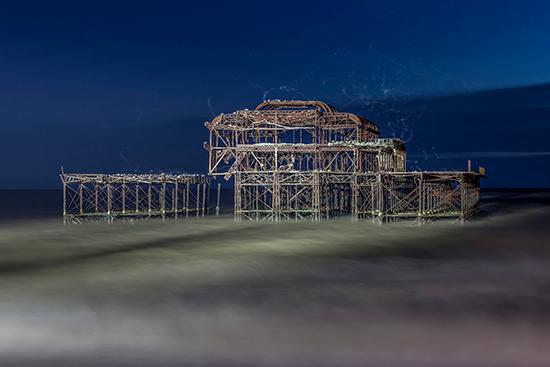Often in photography we work with shutter speeds that are fractions of a second. But we can use them to create exposures of many seconds, minutes and even longer. These long exposures can produce surreal and dreamlike images that go beyond what we see with the human eye.
In this blog, we’ll look at the methods employed to create this shot of Brighton’s West Pier:

The West Pier, Brighton, UK. Canon 5d2, 80mm, 30 secs, f11, ISO 400. (Image courtesy of Michael Brydon)
I could have used a fast shutter speed, opened up the aperture and increased the ISO to gain a correct exposure. But I wanted to echo the ghostly remains of the structure by transforming the stormy sea into an ethereal blur filled with wisps of smoke. This is how I achieved it.
Use a sturdy Tripod
This is essential in creating successful long exposure photographs. The camera must remain completely still for the duration of the exposure. Even the slightest movement will be recorded in the image. Add extra support to your tripod by increasing the weight holding it down. Get creative with your tools. I attached my camera bag to the hook on the centre pole to do this. This shot was taken on extremely stormy night, so I added an extra level of stability by using my coat to shield the camera from the wind.
Lock-up Your Mirror
In SLR cameras the mirror moves upwards just before the shutter opens and this causes vibrations. With fast shutter speeds these vibrations are too slight to have any noticeable effect. But during a long exposure, even the smallest movement will be recorded. The solution is to set the camera to “Mirror Lock Up” (sometimes also called “Exposure Delay Mode)”. In this mode, there is a small delay after the mirror flips up to allow any vibrations to stop before the shutter opens.
Go Hands Free
Pressing the shutter-release button will cause the camera to move regardless of how delicately you try to do it. The self-timer function will prevent this movement if your exposure time is within 30 seconds.
If you want to go beyond 30 seconds then use the “Bulb” mode. This allows the shutter to remain open for as long as you press the release button. In this mode, you will need a cable release. Basic cable releases offer a manual way to keep the shutter open without having to touch the camera. More advanced ones allow you to enter specific time values. Cameras with Wi-Fi capabilities can also be triggered remotely via smart phones, tablets or computers.
Cover Your Viewfinder
With long exposures there is a risk of unwanted light leaking in through the viewfinder. This leads to flares or coloured streaks appearing on the image.
For my shot of the pier, there was a huge potential for this to happen. I was positioned on the pavement above the beach, surrounded by street lamps and the headlights of passing traffic. To overcome this, I removed the eye-cup from the camera and replaced it with the rubber cap attached to the strap. Some cameras even have a built-in shutter that can close off the viewfinder. If yours doesn’t, or you have lost the rubber one that came with the camera, then a small piece of black tape or cloth would be a good temporary DIY option.
Long Exposure Noise Reduction
During long exposures the camera's sensor heats up. This can lead to unwanted noise or hot pixels, which record as either small red or green spots in the image. These may not be visible on the cameras LCD but will show up once you view the image on your computer. Switching the Long Exposure Noise Reduction Mode on will overcome this.
You do not need to limit long exposure photographs to shooting at night. With a Neutral-Density filter you can create fabulous long exposure images in broad daylight. This filter reduces the amount of light up to a whopping 16 stops!
With these tips in mind, get out there and experiment with this technique.
